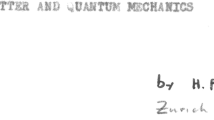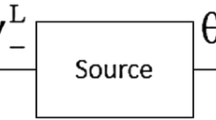Abstract
Orthodox Copenhagen quantum theory renounces the quest to understand the reality in which we are imbedded, and settles for practical rules describing connections between our observations. Many physicist have regarded this renunciation of our effort describe nature herself as premature, and John von Neumann reformulated quantum theory as a theory of an evolving objective universe interacting with human consciousness. This interaction is associated both in Copenhagen quantum theory and in von Neumann quantum theory with a sudden change that brings the objective physical state of a system in line with a subjectively felt psychical reality. The objective physical state is thereby converted from a material substrate to an informational and dispositional substrate that carries both the information incorporated into it by the psychical realities, and certain dispositions for the occurrence of future psychical realities. The present work examines and proposes solutions to two problems that have appeared to block the development of this conception of nature. The first problem is how to reconcile this theory with the principles of relativistic quantum field theory; the second problem is to understand whether, strictly within quantum theory, a person's mind can affect the activities of his brain, and if so how. Solving the first problem involves resolving a certain non-locality question. The proposed solution to the second problem is based on a postulated connection between effort, attention, and the quantum Zeno effect. This solution explains on the basic of quantum physics a large amount of heretofore unexplained data amassed by psychologists.
Similar content being viewed by others
REFERENCES
Physics Today, “Nonlocality gets more real,” December 1998, p. 9.
W. Tittle, J. Brendel, H. Zbinden, and N. Gisin, “Violation of Bell inequalities by photons more than l0 km apart,” Phys. Rev. Lett. 81, 3563 (1998).
W. Tittle, J. Brendel, H. Zbinden, and N. Gisin, “Long-distance Bell-type tests using energy-time entangled photons,” Phys. Rev. A 59, 4150 (1999).
N. Bohr, “Can quantum-mechanical description of physical reality be considered complete?” Phys. Rev. 48, 696 (1935).
P. A. M. Dirac, at d1927 Solvay Conference, in Electrons et photons: Rapports et Discussions du cinquieme Conseil de Physique (Gauthier-Villars, Paris, 1928).
W. Heisenberg, “The representation of nature in contemporary physics,” Daedalus 87, 95–108 (1958).
A. Einstein, B. Podolsky, and N. Rosen, “Can quantum-mechanical description of physical reality be considered complete?” Phys. Rev. 47, 777 (1935).
N. Bohr, “Can quantum-mechanical description of physical reality be considered complete?” Phys. Rev. 48, 696 (1935).
A. Einstein, in Albert Einstein: Philosopher-Physicist, P. A. Schilpp, ed. (Tudor, New York, 1951), p. 669.
M. Gell-Mann, in The Nature of the Physical Universe: the 1976 Nobel Conference (Wiley, New York, 1979), p. 29.
J. von Neumann, Mathematical Foundations of Quantum Mechanics (Princeton University Press, Princeton, NJ, 1955), translation from the 1932 German original.
N. Bohr, Atomic Physics and Human Knowledge (Wiley, New York, 1958), pp. 88 and 72.
W. Pauli, quotations in Chap. 7 of Ref. 27.
For a further development of von Neumann' ideas, see: F. London and E. Bauer, La theorie de l'observation en mechanique quantique (Hermann, Paris, 1939). (Translated into English and included in the anthology of Wheeler and Zurek.)
Eugene Wigner, “Remarks on the mind-body problem,” Symmetries and Reflections (Indiana University Press, Bloomington, 1967), Chap. 13.
S. Tomonaga, “On a relativistically invariant formulation of the quantum theory of wave fields,” Prog. Theoret. Phys. 1, 27 (1946).
J. Schwinger, “The theory of quantized fields, I,” Phys. Rev. 82, 914 (1951).
G. F. Smoot et al., “Structure in the COBE differential microwave radiometer first-year maps,” Astrophys. J. 396, L1 (1992).
J. S. Bell, “On the Einstein–Podolsky–Rosen paradox,” Physics 1, 195 (1964); Speakable and Unspeakable in Quantum Mechanics (Cambridge University Press, 1987), Chap. 4. J. Clauser and A. Shimony, Rep. Prog. Phys. 41, 1881 (1978). A. Shimony, “Contextual hidden-variable theories” in Br. J. Phil. Sci. 35, 25 (1984); Search for a Naturalistic World View II (Cambridge University Press, 1993).
H. Stapp, “Non local character of quantum theory,” Epist. Lett., June 1978. (Assoc. F. Gonseth, Case Postal 1081, Bienne, Switzerland); Colloquium on Bell' Theorem: March 3–4, 1978.
A Fine, “Hidden-variables, joint probabilities, and the Bell Inequalities,” Phys. Rev. Lett. 48, 291 (1982).
N. Bohr, Atomic Physics and Human Knowledge (Wiley, New York, 1958) p.72.
L. Hardy, “Nonlocality for two particles without inequalities for almost all entangled states,” Phys. Rev. Lett. 71, 1665 (1993). A. White, D. F. V. James, P. Eberhard, and P. G. Kwiat,“Nonmaximally entangled states: production, characterization, and utilization,” Phys. Rev. Lett., 83, 3103 (1999).
A. Shimony and H. Stein, “On Stapp's ‘nonlocal character of quantum theory’,” Am. J. Phys. 69, 845 (2001).
H. Stapp, “Reply to “On Stapp's ‘nonlocal character of quantum theory’,” Am. J. Phys. 69, 854 (2001).
M. Tegmark, “The importance of quantum decoherence in brain process,” Phys. Rev. E 61, 4194–4206 (2000).
H. Stapp, Mind, Matter, and Quantum Mechanics (Springer, New York, Berlin. 1993), p. 152 and Chap. VI.
H. Stapp, “The importance of quantum decoherence in brain process,” Lawrence Berkeley National Laboratory Report LBNL-46871; quant-ph/0010029.
H. Stapp, “Whiteheadian process and quantum theory of mind,” Lawrence Berkeley National Laboratory Report LBNL-42143; http://www-physics.lbl.gov/'tapp/stappfiles.html.
H. Stapp, “Attention, intention, and will in quantum physics,” J. Consciousness Studies 6, 143 (1999); quant-ph/9905054.
Wm. James, Psychology: The Briefer Course, Gordon Allport, ed. (University of Notre Dame Press, Notre Dame, IN), Chaps. 4 and 17.
Harold Pashler, The Psychology of Attention (MIT Press, Cambridge MA, 1998).
Author information
Authors and Affiliations
Rights and permissions
About this article
Cite this article
Stapp, H.P. Quantum Theory and the Role of Mind in Nature. Foundations of Physics 31, 1465–1499 (2001). https://doi.org/10.1023/A:1012682413597
Issue Date:
DOI: https://doi.org/10.1023/A:1012682413597




